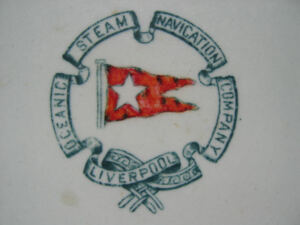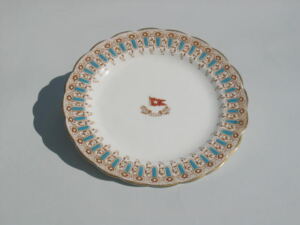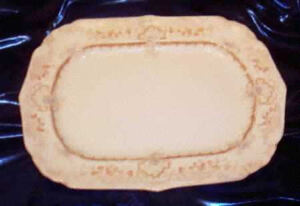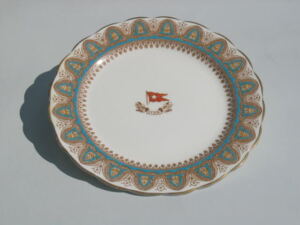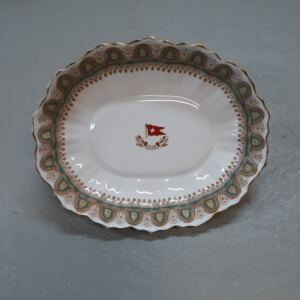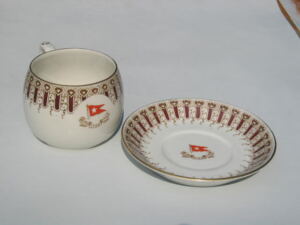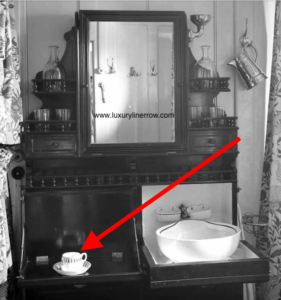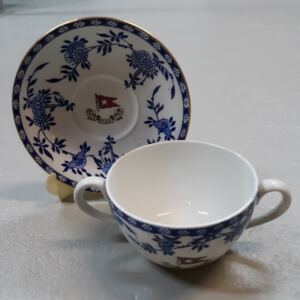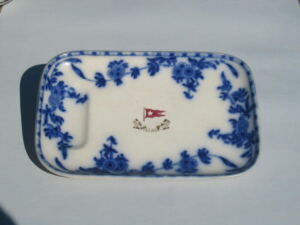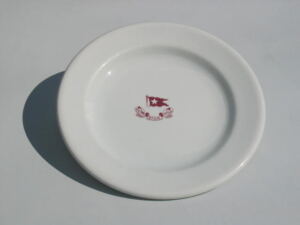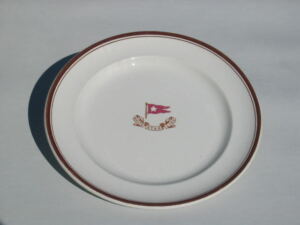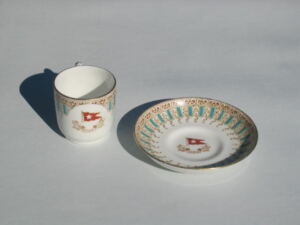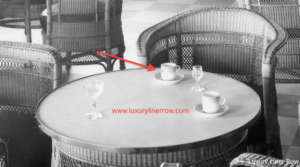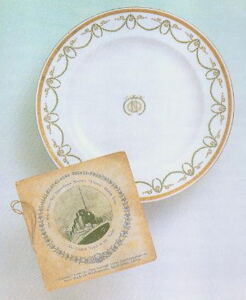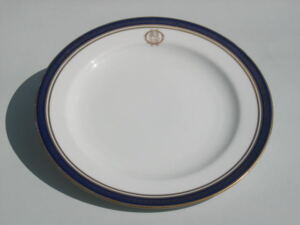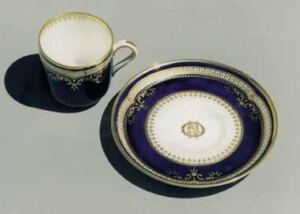China Patterns Used on Titanic
© Russ Upholster, Jr.,
November, 2019, Rev. 5
Preface
For readers that have been following this article since the first posting in 2002, revision 5 includes updated information for manufacturing dates for the “small” Crown pattern, minor data additions to other patterns and wording changes for clarity. This year 2019, marks 37 years of collecting, researching and compiling data for White Star tableware, and I would like to thank the many readers whose comments have been so positive regarding this effort. I hope you continue to enjoy the information presented here as much as I do while doing the research.
If you are interested in collecting ocean liner memorabilia, please visit Luxury Liner Row for a comprehensive display of offerings for many popular steamship lines.
Introduction
When I first started to gather my thoughts for this article, I couldn’t help but think about when I started to collect White Star memorabilia. It was a time when there was very little interest in Titanic. The great ship was still lost, and no one knew how to find her. There were expeditions to locate her, but nothing credible had or would come of it. The mega-movie “Titanic” (1997) wasn’t even yet thought of. It was a time when you could actually find White Star memorabilia at flea markets and antique shops, and better still, you could afford to buy it! Needless to say, since the discovery of the wreck of Titanic, many things have changed, but the one thing that has remained the same is our quest for knowledge about Titanic and all things related to her.
We must keep our perspective regarding Titanic, which is something that many people find difficult to do. If she had not sunk on her maiden voyage, we probably wouldn’t hear much about her today. There’s no question that Titanic was a marvelous ship at the time, but when we look at Titanic for her true purpose, she was merely the second ship in the Olympic-class trio built to bring profits to the International Mercantile Marine. That’s important to remember when we consider the commonality of operation for White Star ships. White Star was no different from a company of today. A company’s identity and reputation must be maintained so a product can be offered for profit. With the unprecedented size and scale of Olympic and Titanic, White Star’s reputation and identity would be assured for many years to come. When a passenger set foot on board, what better way to continue to promote the line’s identity than with attractive tableware that had the company’s name or logo on it? Every time a passenger sat down at a table, the tableware spoke to him. Whether it was a teacup, postcard, or ashtray, you could not mistake the company you were sailing with. It’s those common utilitarian pieces of yesterday that bring us together today.
I’m sure many White Star china collectors have had the same thoughts — that a great discovery would be a stack of Titanic photos showing all her tableware in its intended locations. I think it’s safe to say that no such photos exist. Olympic, also known as “Old Reliable,” lived up to her name and has given us numerous references for her younger sister, but as we cover various patterns, each reader will have to decide if we have uncovered anything new or not. My hope is the information presented here will continue to promote the same positive dialog that has been so beneficial since the original copy of this article was posted to Marconigraph, several years ago.
The first three patterns we will look at are those that were used in the first-, second-, and third-class dining rooms. All three of these patterns have been recovered from the wreck site, and hundreds of identical pieces are in private collections and museums around the world. Photo references from other White Star ships both before and after Titanic, also add their own bit of information and leave little doubt where the patterns were used. Undoubtedly, the best known White Star china is the two different turquoise and brown patterns used in Titanic’s first-class Reception and Dining rooms. Both patterns have acquired many different names over time, given to them by well-meaning but uniformed persons, but to my knowledge, no one has ever found tangible evidence that either pattern had a specific manufacturer’s name until now. After many years of searching, in late 2002 I finally found a piece made by Brownfield’s (the original potter), with the “arched” decoration that had the proper pattern identification markings on the underside. The piece was made in February 1882, and the proper name for the pattern is “Crown”. To avoid further confusion, from this point forward I’ll only use the proper name of Crown for White Star’s turquoise and brown first class table service. I’ll continue to refer to the pattern found on smaller pieces of china such as the side plate shown below as the “small” Crown pattern. Also if any reader can provide actual proof from a manufacturer or distributor that, a pattern name does exist for any of the un-named patterns you will read about in the following article, I will gladly give proper credit to that person or persons, and I will incorporate that information into future revisions of this article.
First-Class Service
When Titanic’s first-class passenger entered the dining room, they would have been greeted by the small Crown pattern side plates as shown to the left. This pattern was first produced by Wm. Brownfield & Son and carried the British Registration Number 7044 (issued in1884). A British registration number is much like an U.S. patent number, it protects a design by giving the number holder exclusive rights to the design. In the case of a china table service, a protected design can include either the body shape of the ware or the decoration applied to it. To my knowledge at this writing, the earliest production date that has surfaced on a small Crown pattern piece that was made for White Star is 1889, and if Brownfield ever put the actual pattern number on the china I’ve never seen or heard of it. All turquoise and brown colored pieces from the first-class service were made of fine bone china and therefore are very fragile. Brownfield ceased to operate after 1891, but a known maker of this popular pattern during Titanic’s short life was Bridgwood (Bridgwood most likely bought the printers plates when Brownfield ended business). Because many White Star pieces are back marked “Stonier Co. Liverpool” may often mistakenly believe that Stonier was the maker of the china. Stonier only brokered and distributed china, and did not actually produce the ware for White Star. John Stonier (founder of the company) did, however, partner with Duncan Bishop in 1891 to form a pottery company called Bisto. Stonier Co. of Liverpool brokered Bisto tableware, and in turn Bisto china was sold to White Star. Virtually all pieces of the Crown pattern that we see today carry two registration numbers, 117214 and 324028 (1888 and 1898 respectively). Several writers have reported that Rd.No.117214 was issued in the year 1889. According to information from the British Patent Office in London, writers using the 1889 date for Rd.No.117214 are in error. Patent Office records show the first registry number issued for the year 1889 was 117800; therefore, Rd.No.117214 would have been issued in the later part of 1888. One researcher has reported that registry number 117214 was issued to protect the White Star house flag and name ribbon below, and number 324028 was issued to protect the border decoration. When I corresponded with the U.K. Public Records Office regarding the double registration numbers, they stated that they had no information or reason for the multiple numbers. The earliest pieces of White Star china that I’ve been able to date that bears the house flag and White Star Line ribbon is 1889, and all pieces that I have seen that were made prior to 1889 have had the circular Oceanic Steam Navigation Co. logo on them. Red Star Line also used both Crown patterns and they carry the same registry numbers as White Star pieces, therefore I don’t think that we can conclude that Rd. No.117214 was issued to protect White Star Line’s identity. In revision 3 of this article, I stated that it might be possible that the second registry number 324028 may have been issued to the potter in 1898 to protect the scalloped edge design of the white ware being used. However, since revision 4, both large and small Crown pattern pieces have surfaced with a production date of 1889. The date is well before the date when 324028 was issued, making it doubtful that 324028 was issued for protecting the border decorations or the scalloped edge body design. Information regarding both registry numbers continues to remain elusive at best, but I will continue to be watchful for new data.
In addition, the manufacturing date of 3/1912, found on the underside of some first class pieces, is often debated as a date that was specific to Titanic. It is true that pieces bearing 3/1912 (as well as other dates) have been salvage from Titanic’s wreckage, but White Star used the same patterns on many ships thereby it’s incorrect to assume that pieces bearing the 3/1912 date were intended for use on Titanic only.
Before moving on I would also like to clear up some confusion about the name “Wisteria” that we often hear in reference to the small Crown pattern. I can understand why some persons may think of a lavender Wisteria vine when looking at the pattern, but Wisteria is not the pattern’s name. Brownfield’s did make a pattern called Wisteria, but it’s not similar to the pattern that White Star used. If the name Wisteria was assigned by a potter after Brownfield ceased to operate, I have not been able to document that. For your reference, shown above is a platter decorated with Brownfield’s Wisteria pattern.
Titanic’s first-class passengers would have enjoyed their dinner selections off of the Crown pattern plates shown at the right. Brownfield was the originator of the Crown pattern, but by the time Titanic came into being it was most likely that Spode actually made the pieces for Stonier. Spode records show that several printing plates were purchased from Brownfield’s when they ceased operations and I’ve been able to positively identify Crown pattern pieces made with the Spode trade mark as late as 1908. Other than dinner plates there was at least one other piece of china used on Titanic that carried the Crown pattern. That piece was an oval shaped serving bow that measured 8” x 10”. The Crown pattern has often been referred to as “Celtic” or “Gothic Arch”, but again, those are names that have been adopted over time but were not assigned by the potter. At this writing the earliest known production date is 1889 on White Star Crown patterned pieces(both large & small), that strongly suggests that it was first used on Teutonic or Majestic of the 1889/1890 era. It was previously thought that the Crown pattern was first seen on Celtic of 1901.
First-Class Cabin Service (?)
The pattern shown above was not included in the original writing of this article in 2002, as it was not known to have been salvaged from Titanic at that time. However, conversations with Bill Sauder (Consultant to RMS Titanic Inc.), has revealed that two additional china services were indeed recovered from the Titanic wreck site. The pattern at left is actually the same small Crown pattern as shown above but with the turquoise coloring being replaced by brown. The pattern and color combination is not new to collectors, but its availability is much more limited than that of the turquoise variety. While this service was most often made from a relatively thin grade of earthenware, it was also made in the same fine bone china as its turquoise counterpart. All pieces that I have ever seen with the brown enameling have been dated between 1902 and 1913 so that tracks well within its turquoise cousin’s production life. We most often see what are referred to as tea or hot chocolate sets with the brown color, and they normally bear the same double registration numbers as the turquoise variant. As far as I can determine large Crown pattern pieces with the brown color were never produced, although White Star did use the brown colored small Crown pattern on tableware including side plates, egg cups and slop basins. I have found what I think is an interesting twist to this pattern and color combination. In a photo of a second-class cabin on board Olympic, sitting on the dressing table is a chocolate sized cup and saucer with the brown coloring. I know what you’re thinking: How can he tell what the colors are in a black and white photo? Based on looking at many black – and – white photos where I know the decoration color is turquoise, the turquoise has always appeared light to medium gray. In the Olympic photo, the decoration color is much darker and some of it even appears black. In revision 3 of this article I speculated that the brown colored pattern may have been used as second class cabin service, but based on information since supplied by Titanic researcher and author Daniel Klistorner, the photo I mentioned was taken in a section of E deck second class cabins that were alternately used for first class. Daniel also explains that there were no pantries fitted through out the second class accommodation and the cup & saucer were most likely “borrowed” for the photo from a first class pantry on E deck. The nearest pantry on Olympic (in 1914 when the picture was taken) would have been just down the hall in the location where Titanic’s cabin E63 was located. On Titanic, this area was being used as first class cabins (up to E 68), but there was only one stateroom pantry on this deck and it was right near the grand staircase landing. In any case, the cup & saucer seen in the photo would have come from what was intended to be a first class pantry, therefore it would be reasonable to believe that brown colored pattern pieces were probably used for first class cabin service. Another bit of information regarding pantry service for first class was “almost” obtained during one of Jim Cameron’s exploration of Titanic. A pantry located just behind cabin A4 was discovered and the pantry contained a storage rack of small Crown pattern saucers that were intact. Unfortunately the color on the saucers was badly worn and no determination to that end could be made……maybe next time?
Second-Class Service
The second-class dining room on Titanic was set with a very attractive pattern of restaurant-grade Delft china. It is generically referred to as “restaurant grade” because it is a quality of dinnerware that was, and is, universally used in restaurants everywhere. (It is actually earthenware covered in clear glaze.) The decoration gets its name from the shortened title of Blue Delft, or Holland Blue Delft. The city of Delft, Holland, became popular for manufacturing blue-on-white wares after Dutch trading ships carried examples back from China around 1700. Countless patterns of Blue Delft china have been made in the past, and they continue to be made today. The Delft pattern used by White Star was first registered in September, 1871, and has remained so popular that it’s still available today. The dinner plate shown above was produced by Minton in 1889 and was brokered by Stonier Co.
Another interesting fact about the Delft pattern is that it was also produced for White Star in what is called “Flow Blue”. Flow Blue is well known in china circles, but to those unfamiliar with the term, it is used to describe when the cobalt blue decoration starts to “flow” or combine with the white body or clear glaze, giving the decoration a cloudy- or misty- edged appearance. Josiah Wedgwood II is credited with producing the first flow blue in 1820, and soon after he perfected the process many potters started producing it. Flow Blue was extremely popular from about 1825 to 1915. Bisto, Foley, and Minton are known makers of the delft pattern for White Star with Minton being the most prolific. The Flow Blue asparagus dish above was produced by Bisto in 1915 and brokered by Stonier.
Third-Class Service
Third-class china was nothing more than open stock white-ware pieces with the White Star logo applied. During the Edwardian period, a table set with third-class wares would have looked very plain in comparison to a first-class or second-class table. The first thing you may notice about third-class service is that its entire logo is printed with a single maroon color. This is in keeping with a minimum investment by the purchasing party by eliminating the need for hand decoration and the need for multiple kiln firings. Third-class china most often lacks any maker’s mark or date code information on its underside (producing more cost savings) but frequently carries the Stonier Co. trade name. Stonier would have brokered third-class wares to many potters, but the plate shown above was made by Wedgwood in February 1924.
Shown above is the other pattern recovered from Titanic that was not covered in the original article. This is another of White Star’s patterns that we rarely see. I believe this was also used as a third-class service on Titanic based on its simple design and because of a reference photo I have showing the same pattern in the third-class dining room of White Star’s RMS Regina of 1922. This service was made from the same weight earthenware as the more common third-class service shown above, and the two patterns were most likely used together. Bill Sauder reports that Cunard used a “hand me down” approach to stocking third class china on the Queens as well. By the 1960s, china “retired” from the Aquitania and silver plate from White Star was used in third-class on the Queen Mary. Of the few pieces that I’ve ever seen of this pattern, I’ve not found any makers marks or date codes. The multiple colors and some hand decoration on this pattern leads me to believe that it may have been used in a higher class of service at one time, but when Titanic sailed White Star could have already been starting to phase it out of service and relegated it to third-class. The example shown at the left has the transfer printed White Star Line ribbon and a hand-painted burgee. As a side note, this pattern was also produced with green colored striping but with the circular OSNC center logo instead of the burgee and name ribbon below. To date there is no evidence that the green variant was used on Titanic.
The Verandah Cafés
The Verandah Cafés on Titanic were light and airy retreats far away from the bustle of most of the first-class areas. They were the perfect place to enjoy an afternoon tea, coffee, or perhaps a favorite cordial. Brightly lit by large windows flanked by palms and ivy and set with wicker furniture, one could imagine a midsummer crossing and enjoying friends and conversation in such charming surroundings. A few early photos of the Verandah Cafés on Olympic shows the small Crown pattern in use, and I would have to believe the same held true for Titanic. Shown above is a demitasse set that would have been used in Titanic’s Verandah Cafés.
à la carte Restaurant (?)
Titanic’s à la carte Restaurant is a room around which considerable discussion and speculation has taken place as to what china pattern (or patterns) was used there. One thing is certain — Titanic’s short life did not permit several different patterns to be employed there. Royal Crown Derby supplied the Restaurant service for Olympic, and records show that orders for pattern Rd.No.575573 (1910) were placed by Stoniers on January 31,1911, for Olympic, with delivery requested for May. (On February 2, 1911, Stonier requested that the delivery date be changed to the end of April) A repeat order would follow for Titanic with a required delivery of December, 1911. (On October 23, 1911, that date was changed to the first of March, 1912) Royal Crown’s service has been salvaged from Titanic so there’s no doubt that it was used on board. Also, if we look at the advertising card that Royal Crown Derby used to promote their product and good fortune as a supplier to White Star’s newest and grandest creation, it pictures the à la carte Restaurant. With Olympic still fresh in everyone’s mind, Royal Crown Derby saw a promotional opportunity that could not be passed up. They produced the advertising card boasting of Titanic, touted the splendid Royal Crown Derby product being employed, and photographed the restaurant (on Olympic, of course) where their china was going to be used. I realize this doesn’t conclusively prove that Royal Crown Derby’s china was used in the à la carte Restaurant, but it is one more bit of pretty good evidence. After all, why would a company produce an advertising card that pictured a room in which their product was not used? As a side note, it should be pointed out that the “swag” decoration used on the Royal Crown Derby pattern, bears a striking resemblance to the individual ceiling light fixtures used in the à la carte Restaurant on Olympic and Titanic. The photo above is from the Royal Doulton collection.
Remaining China Patterns Used on Titanic
Although additional china patterns not covered in this article have been salvaged from Titanic’s wreckage, to my knowledge, only three patterns remain that carried positive White Star identification. At this time, credible 1912 photographic evidence or documents as to where the following patterns were used continues to escape historians. If those references do exist, they have not been made public. There have been numerous suggestions about where various patterns were used on board, but it’s usually just an opinion with no documentation to back up any claims. Here are the remaining patterns that have been salvaged from the wreck that bear definite evidence of being used by White Star.
Café Parisian (?)
The reference photo above shows Spode’s pattern number 1/9608, adorned with the entwined OSNC logo (Oceanic Steam Navigation Co). Often referred to as “Greek Key” (but not a Spode given name), this pattern was first available in 1899 and was used by White Star from 1911 until at least 1933. It was one of Spode’s prestigious cobalt patterns, and with its rich decoration I believe it would have only been used in Titanic’s first-class service. With the wide variety of serving pieces found in this pattern, it suggests that it was a complete dining service and not just for tea. Which begs the question: Where was it used? Was this an additional pattern used in one of Titanic’s first-class salons, or could it have been used in the Café Parisian?
Special Service / VIP (?)
The next pattern is another from the Spode Cobalt series with the photo above from Ken Marschall’s collection. Spode’s pattern R4332, Rd.No.580303 (1911), was easily the most expensive and prestigious china service on board. It was a china service with an incredible amount of cobalt blue and gold decoration that gives it an extremely rich appearance. While the decoration was never given a formal name by Spode, “Boston” was Spode’s given shape name for the demi set and “Sutherland” is the shape name for the plates in this service. Spode made a service named “Lancaster”, and it is a near copy of the same pattern used on Titanic. White Star used a number of Spode’s cobalt patterns, and some have suggested that two or more patterns were used in the à la carte Restaurant of Titanic, including pattern R4332 and the Royal Crown Derby pattern mentioned above. This is highly unlikely for a number of reasons. According to one researcher, only 190 pieces of this pattern were ordered by White Star for use on board although Spode’s records could not confirm that number. This is obviously not possible since each place setting would comprise far more pieces than the 190-piece figure would allow, not- to- mention larger serving pieces and miscellaneous items of tableware. Of course, one also has to consider breakage. The likelihood that two separate patterns of china were used in the same restaurant at different meals doesn’t seem reasonable. Even on very large ships, storage was always in short supply, and the space required for a dedicated “afternoon service” would be considerable. Also, assuming a low order number, the entire restaurant could not be served at the same time using this pattern. It is more likely that this pattern was used perhaps in the two largest suites (B-51-53-55 and B-52-54-56), or it may have been a special VIP service used at private gatherings. As I continue to search for information regarding this elusive pattern, and based on the only pieces of this pattern that have ever surfaced, my thoughts have turned from it being a dinner service, towards it being something along the lines of a luncheon service. I say this because the only pieces of R4332 that have surfaced are demitasse sets; small side plates, and plates less than 9” in diameter. If it ever was used as a dinner service I would think by now that at least a few pieces other than those just mentioned would have surfaced. White Star did use silver plated pieces that could have been use to make up the difference for pieces lacking in the R4332 pattern, but White Star did not use silver plated tea cups and saucers in place of the china that would have been required if this was a dinner service. Again this is all just speculation since there are no known photographs showing this pattern in use, but far too few pieces have ever existed to have ever been used in a room of any significant size. It’s also known that demitasse sets in this pattern were used as presentation gifts to visiting VIPs, further suggesting its status. Regardless of where this pattern was used, it would have been stunning to see a table regaled in this pattern!
Deck Service
The last pattern shown is a rather simple, but attractive one. It has a plain white body with a two-colored logo and a gilded rim. That combination of decoration would not have been found in third-class service as some believe. This pattern is not often seen, and of the few pieces that have surfaced, the Bridgwood potters mark has been the only potters mark that I’ve seen. Stonier Co. distributed the pattern, and on occasion a piece with the Stonier Co. mark will surface. As for manufacturing dates, I’ve yet to see a date mark for this pattern. This pattern could have been produced from about 1889 until White Star’s last days in 1934. I have found no evidence to suggest that this pattern was ever supplied to White Star as a full table service, and of the few pieces that have surfaced, they are most often those associated with hot chocolate or buillon sets (beef tea). With gold gild it’s reasonable to believe that this pattern would have been used for an upper class of service, and it is known to have been used by a White Star officer on deck of Celtic as witnessed in a photo from circa 1904.
Smoking Rooms & Lounges
All photographic reference I’ve seen for the smoking rooms and lounges on board, not only Olympic but also other White Star ships of the period have either been devoid of china service or I could not determine to a reasonable degree what pattern was in use there. Because one of Titanic’s Verandah Cafés had an entrance directly into the first-class Smoking Room, male patrons could have carried their tea or coffee with them. Therefore, we can reasonably assume that small Crown patterned pieces may have been found there. The first-class Smoking Room also had a well stocked bar and pantry inside the starboard entrance, and I’ve often wondered if a limited china service may have been found there as well. As for the first-and second-class lounges and the second-class Smoking Room, it’s reasonable to believe that Titanic’s respective class of dining-room service would be found there. It’s important to remember that the use of china in the smoking rooms would be limited at best. The smoking rooms were male retreats where sprits of a higher caliber rather than tea and coffee would be enjoyed! The reason for using the respective class of dining room service in Titanic’s lounges, and to a limited extent in the smoking rooms, is based simply on the logistics of running a large ship. Where nothing more than a tea or coffee service would be required, it would be economical to draw from a pantry service that already contains the pieces that are needed.
Summary
This concludes the information regarding Titanic’s china service that I have been able to compile to this date, November, 2019. It seems Titanic never stops to surprise us, and she surely never stops to fascinate us. If exploration or salvage of Titanic continues, additional patterns or coloration of her dinnerware could be uncovered. Also, there is always the chance that some credible document or photograph could surface that may shed new light on the information presented above. I intentionally did not included non-patterned pieces that we know were used on Titanic because there was nothing unique or special about them. I’m referring to pieces such as plain white or brown earthenware dishes or tea pots for example. Those pieces could have been found on any number of ships and those used on Titanic either had no line markings at all, or at best would have had only the line name or initials on the underside. Should I uncover additional information regarding Titanic’s china service or should someone else provide new documented information regarding the same, I’ll be sure to revise this information again giving proper credit.
Acknowledgments:
I would like to thank the following people for helping make this article possible by sharing their time, knowledge, and information from their personal collection’s. Adam Barlow, Richard Faber, Brian Hawley, Daniel Klistorner, Mary Lee, Ken Marschall, Bill Sauder, Eric Sauder, Sandy Upholster, and Pam Woolliscroft. A special thanks to Parks Stevenson for hosting the former Web site “Marconigraph” where this article was first presented.
References
Adam Barlow – Collection
Cushion – British Ceramic Marks
Brian Hawley – Collection / Luxury Liner Row
Daniel Klistorner, Co-author – “Titanic: The Ship Magnificent”
Kovels – New Dictionary of Marks
Mary Lee – Collection
Lynch / Marschall – Titanic: An Illustrated History
Ken Marschall – Collection & Titanic exploration data
McCluskie – The Anatomy of the Titanic
Montlucon / Lacoudre – Les Objets Du Titanic
Replacements, Ltd.
Richard Faber – Collection
Royal Doulton, Ltd.
RMS Titanic, Inc. – Bill Sauder, Consultant
Steve Birks – The Potteries.Org
The Titanic Historical Society – The Titanic Commutator
Titanic International – Voyage
Spode Museum Trust – Pam Woolliscroft
U.K. Public Records Office – National Archives
All photos are from the author’s collection unless otherwise noted.
